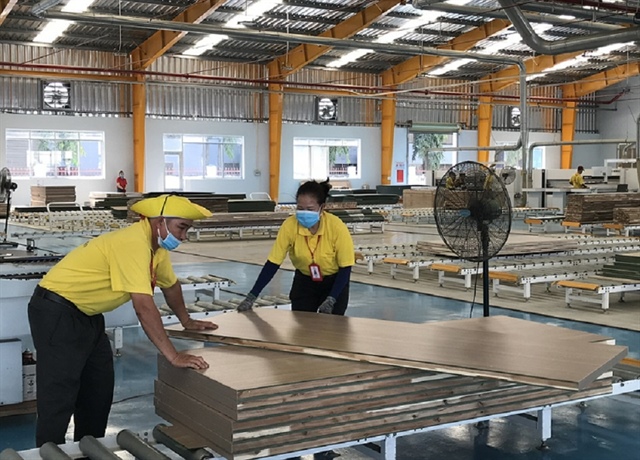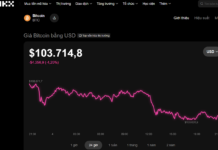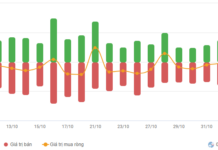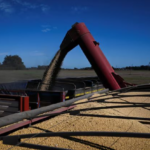
Factory floors are bustling with workers returning to their jobs in full force after the recent traditional Tet holiday. Illustrative image: DNCC
|
Back to production after Tet holiday
Production activities at the furniture manufacturing factory of Duc Thien Co., Ltd in Tan Uyen town (Binh Duong province) are bustling as workers return to work in full force after a week-long Lunar New Year holiday.
Mr. Le Ha Trong Chau, the company’s production director, said that more than 150 workers at the company’s factory are working hard to meet export orders until June. Compared to the same period last year, the company’s exports to the American market have increased by about 10%.
“The increase in export orders in the early months of the year is the driving force for us to expect smooth and successful production and business operation this year after a challenging and difficult year. We hope that business will increase by 20-30% compared to last year,” Chau shared.
Not only Duc Thien Company, other wood processing businesses also said that production orders are gradually returning.
At the seminar introducing the Vietnam International Furniture and Handicrafts Export Fair (VIFA EXPO 2024) on February 20, Mr. Tran Ngoc Liem, Director of the Vietnam Chamber of Commerce and Industry branch in Ho Chi Minh City, said that as of the end of 2023 and the beginning of 2024, the export of wood and wood products has witnessed positive signs with over 1 billion US dollars.
Similarly, in the textile industry, some businesses said that orders are starting to pick up again after a year of decline due to the tightening of spending by consumers in major importing markets.
Mr. Pham Quang Anh, Director of Dony Garment Company Limited, said that almost all of the company’s labor force has returned to work in the factory to keep up with orders from customers in the United States, Singapore, Cambodia, Malaysia, etc.
“Currently, our production orders are scheduled for workers to work until the end of April. This figure is double compared to the same period last year. The company’s target this year is to achieve 15% growth,” Anh said.
According to the statistics of the Ministry of Industry and Trade, the production index of the textile industry in the first month of the year is quite optimistic. Specifically, the weaving industry increased by 46.2%; garment production increased by 20.9%; textile products from natural fibers increased by 57%; normal clothing increased by 25.8%, compared to the same period last year.
Companies in other manufacturing sectors such as mechanics and electronics acknowledged that thanks to slightly increased orders compared to the same period last year, the labor force returned to work immediately after the Tet holiday.
Notably, grain and food companies are showing a busy production with the current increase in production. Mrs. Le Thi Giau, Chairwoman of the Board of Directors of Binh Tay Food Joint Stock Company, said that from the 6th day of Tet until now, employees at the company have had to work overtime continuously to meet orders. The company is also recruiting 50 more temporary workers to increase production.
“Currently, we have orders for the whole year, even not enough to sell. The company plans to export about 800-1,000 containers this year and expects revenue to increase by over 300%,” Giau shared.
Ms. Ly Kim Chi, Chairwoman of the Ho Chi Minh City Food and Foodstuffs Association (FFA), also said that since before the Lunar New Year, food and food companies have continuously received new export orders. Many businesses have received orders to produce until March and April, with some stable businesses until June.
“Global inflation is decreasing, and the inventory level of this group of goods in the world is also decreasing, so partners are returning to place orders. Many businesses have recruited more employees to timely meet export orders,” Chi said.
Businesses believe that the value of exports in the first month of the year is usually quite low, but this year’s growth shows many positive signals for Vietnam’s exports.
Challenges ahead
Although the start of the new year is optimistic, businesses and analysts still have concerns because production orders are not stable, smaller in scale, and more short-term compared to before, with many unpredictable factors and prolonged market difficulties in the future.

The transportation fees for containers to Europe and the US are rising. In the picture, a ship passes through the Suez Canal, heading to the Red Sea – Photo: EPA |
Mr. Le Ha Trong Chau said that although orders have increased by 10% compared to the same period last year, Duc Thien Company’s exports have only reached about 70% compared to the time before the Covid-19 outbreak.
Similarly, for the leather and footwear industry, production orders are still quite low and have not recovered as other industries. The number of workers returning to work is still low.
According to Mr. Tran Ngoc Liem, Director of the Vietnam Chamber of Commerce and Industry branch in Ho Chi Minh City, the wood industry in particular, and the export industries in general, are facing many challenges due to increasingly complex conflicts between countries. This affects the business activities of businesses.
Sharing the same view, Mr. Dien Quang Hiep, General Director of Minh Phat 2 Co., Ltd, said that this year, export companies still have to deal with the continued consequences of 2023, such as political conflicts, wars, tensions in the Red Sea, etc.
More worryingly, the disruption of transport related to the Red Sea region is increasing the cost of shipping goods to Europe and the US.
At present, freight rates for container deliveries to the two largest furniture export markets, the US and Europe, are disrupted, which is a constraint for timely order fulfillment. Disrupted transportation has caused freight rates to double, specifically, the fare to the US is over $4,000 per container, putting pressure on exporting businesses in terms of input costs.
Meanwhile, Mr. Tran Quoc Manh, Chairman of Sadaco, also said that the current growth in production orders is because the exports of the wood industry decreased too deeply compared to the same period last year. Current orders are small, unstable, and prices have not increased. In addition, increasing costs create great pressure on businesses.
Notably, according to Mr. Manh, the current market trend for wood exports has changed significantly, with orders now being received only for a short period of time, and importers are demanding higher requirements for the models and quality of products.
“Current orders are very different from before. We no longer export tens of containers, but instead, businesses focus on sample products to match the market demand. Creating sample products is quite costly and requires skilled personnel, which is also an issue that businesses have to solve,” Manh said.

Activities at an export wood manufacturing company. Photo: H.Như |
Similarly, although the food and food industry has good growth potential, according to Ms. Ly Kim Chi, the market requirements of importing countries are increasingly stringent in terms of standards and technical barriers, which poses many challenges for domestic businesses.
“We always warn businesses to focus on the quality of exported goods, increase the export of organic food, and safe food to meet consumer trends worldwide,” Chi said.
Competing in exports at the present stage requires businesses to engage in deep processing. Another important issue that businesses in all industries need to strive to achieve is green production and environmentally friendly. Moreover, the requirements that major brands and importing markets set are becoming stricter.
All requirements require investment in machinery, technology, etc. To do so, businesses need capital, while domestic businesses mainly have small and thin capital.
In the current context, businesses with a common understanding believe that one of the urgent tasks is to maintain traditional customers and try to expand new markets. In addition, they need to strengthen the diversification of sales channels from traditional to non-traditional channels.
Furthermore, restructuring management, reducing input costs, and investing in improving production and business to “green” production step by step are also necessary tasks to compete and prepare well for market recovery as in the past.
“What is important for businesses at this time is to be cautious and calm to come up with an effective business strategy,” Dien Quang Hiep concluded.
Hung Le





































